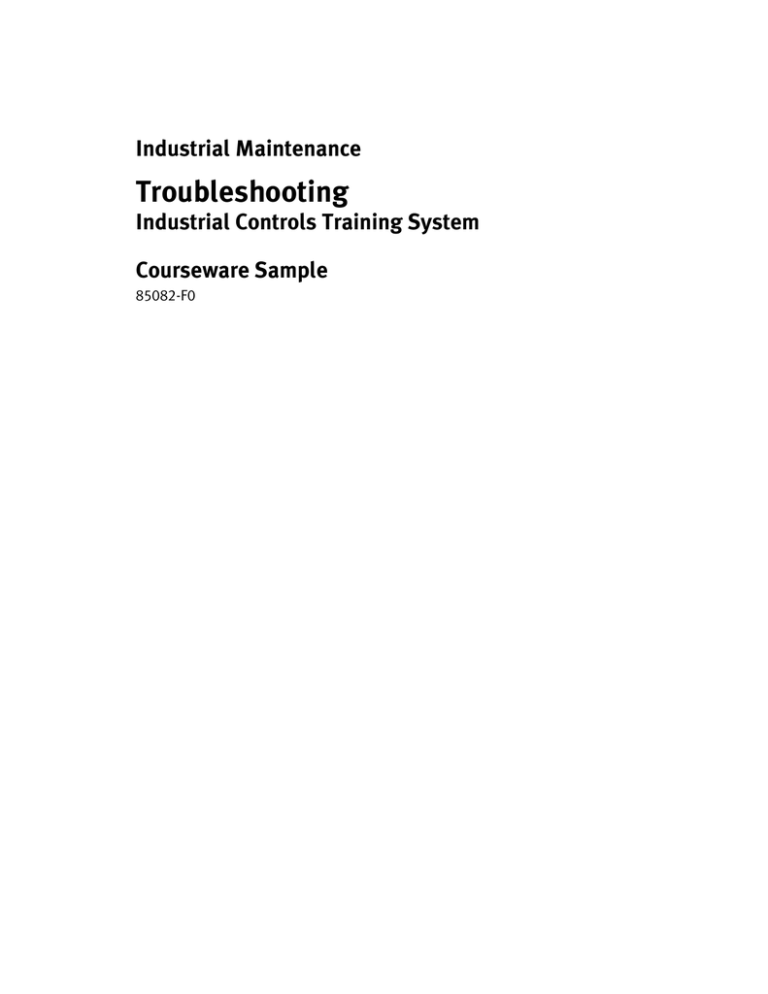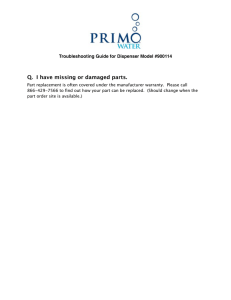
Industrial Maintenance
Troubleshooting
Industrial Controls Training System
&RXUVHZDUH6DPSOH
85082-)0
Order no.:
85082-00
First Edition
Revision level: 09/2014
By the staff of Festo Didactic
© Festo Didactic Ltée/Ltd, Quebec, Canada 2007
Internet: www.festo-didactic.com
e-mail: did@de.festo.com
Printed in Canada
All rights reserved
ISBN 978-2-89640-225-0 (Printed version)
ISBN 978-2-89747-273-3 (CD-ROM)
Legal Deposit – Bibliothèque et Archives nationales du Québec, 2007
Legal Deposit – Library and Archives Canada, 2007
The purchaser shall receive a single right of use which is non-exclusive, non-time-limited and limited
geographically to use at the purchaser's site/location as follows.
The purchaser shall be entitled to use the work to train his/her staff at the purchaser's site/location and
shall also be entitled to use parts of the copyright material as the basis for the production of his/her own
training documentation for the training of his/her staff at the purchaser's site/location with
acknowledgement of source and to make copies for this purpose. In the case of schools/technical
colleges, training centers, and universities, the right of use shall also include use by school and college
students and trainees at the purchaser's site/location for teaching purposes.
The right of use shall in all cases exclude the right to publish the copyright material or to make this
available for use on intranet, Internet and LMS platforms and databases such as Moodle, which allow
access by a wide variety of users, including those outside of the purchaser's site/location.
Entitlement to other rights relating to reproductions, copies, adaptations, translations, microfilming and
transfer to and storage and processing in electronic systems, no matter whether in whole or in part, shall
require the prior consent of Festo Didactic.
Information in this document is subject to change without notice and does not represent a commitment on
the part of Festo Didactic. The Festo materials described in this document are furnished under a license
agreement or a nondisclosure agreement.
Festo Didactic recognizes product names as trademarks or registered trademarks of their respective
holders.
All other trademarks are the property of their respective owners. Other trademarks and trade names may
be used in this document to refer to either the entity claiming the marks and names or their products.
Festo Didactic disclaims any proprietary interest in trademarks and trade names other than its own.
Safety and Common Symbols
The following safety and common symbols may be used in this manual and on
the equipment:
Symbol
Description
DANGER indicates a hazard with a high level of risk which, if not
avoided, will result in death or serious injury.
WARNING indicates a hazard with a medium level of risk which,
if not avoided, could result in death or serious injury.
CAUTION indicates a hazard with a low level of risk which, if not
avoided, could result in minor or moderate injury.
CAUTION used without the Caution, risk of danger sign ,
indicates a hazard with a potentially hazardous situation which,
if not avoided, may result in property damage.
Caution, risk of electric shock
Caution, hot surface
Caution, risk of danger
Caution, lifting hazard
Caution, hand entanglement hazard
Notice, non-ionizing radiation
Direct current
Alternating current
Both direct and alternating current
Three-phase alternating current
Earth (ground) terminal
© Festo Didactic 85082-00
III
Safety and Common Symbols
Symbol
Description
Protective conductor terminal
Frame or chassis terminal
Equipotentiality
On (supply)
Off (supply)
Equipment protected throughout by double insulation or
reinforced insulation
In position of a bi-stable push control
Out position of a bi-stable push control
We invite readers of this manual to send us their tips, feedback, and
suggestions for improving the book.
Please send these to did@de.festo.com.
The authors and Festo Didactic look forward to your comments.
IV
© Festo Didactic 85082-00
Table of Contents
Preface ................................................................................................................. VII
About This Manual ................................................................................................ IX
Unit 1
Introduction to Troubleshooting .................................................. 1
Ex. 1-1
Voltmeter Method of Troubleshooting ........................................ 5
Ex. 1-2
Ohmmeter Method of Troubleshooting ..................................... 11
Ex. 1-3
Troubleshooting a Basic Electrical Circuit ............................... 15
Unit 2
Troubleshooting Basic Motor Control Circuits ........................ 19
Ex. 2-1
Troubleshooting a Manual Reversing Starter Circuit .............. 23
Ex. 2-2
Troubleshooting a Motor Starter with Jogging Circuit ............ 27
Ex. 2-3
Troubleshooting a Plugging with Time Relay Circuit .............. 31
Unit 3
Troubleshooting PLC Circuits.................................................... 35
Ex. 3-1
Troubleshooting a PLC Circuit................................................... 37
Ex. 3-2
Troubleshooting a PLC Reversing Motor Starter with
Jogging Circuit ............................................................................ 41
Ex. 3-3
Troubleshooting a PLC Motor Starter with Jogging Circuit ... 45
Unit 4
Troubleshooting AC and DC Drive Circuits .............................. 49
Ex. 4-1
Troubleshooting an AC Drive Circuit ........................................ 51
Ex. 4-2
Troubleshooting an AC Drive Braking and Jogging Circuit ... 53
Ex. 4-3
Troubleshooting a DC Drive Circuit........................................... 57
Appendix A Equipment Utilization Chart ....................................................... 61
Appendix B Basic Setup and Lockout/Tagout Procedures.......................... 63
© Festo Didactic 85082-00
V
Preface
© Festo Didactic 85082-00
VII
About This Manual
The exercises in this manual, Troubleshooting, complement the exercises contained
in the manuals Basic Controls, Programmable Logic Controller, and Motor Drives.
The present manual is divided into four units:
&
Unit 1 introduces troubleshooting methods;
&
Unit 2 introduces the troubleshooting methods that apply to basic motor
control circuits. The equipment supplied with the Fundamental Controls
system, Model 8036-0 or Basic Controls system, Model 8036-1 (or 8036-E),
is required to perform this unit;
&
Unit 3 introduces the troubleshooting methods that apply to circuits where
a PLC is used. The equipment supplied with the Programmable Logic
Controller system, Model 8036-2, is required to perform this unit;
&
Unit 4 introduces the troubleshooting methods that apply to AC and DC
drive circuits. The equipment supplied with the Motor Drives system, Model
8036-3 (or 8036-B), is required to perform this unit.
Each exercise is divided into the following sections:
&
A clearly defined Exercise Objective;
&
A Discussion of the theory involved in the exercise;
&
A Procedure Summary which provides a bridge between the theoretical
Discussion and the laboratory Procedure;
&
A step-by-step laboratory Procedure.
Safety Considerations
Make sure that you are wearing appropriate protective equipment before performing
any of the exercises in this manual. Remember that you should never perform an
exercise if you have any reason to think that a manipulation could be dangerous to
you or your teammates.
Reference Material
Refer to the component data sheets for detailed information about the devices.
These data sheets are included on the CD supplied with the manual Basic Controls,
Lab-Volt p/n 39163 (or 87774).
Prerequisite
To perform the exercises in this manual, you should have completed the following
manuals:
&
&
Units 1 and 2:
Unit 3:
&
Unit 4:
Basic Controls, p/n 39163 (or 87774);
Basic Controls, p/n 39163 (or 87774), and Programmable Logic
Controller, p/n 39436;
Basic Controls, p/n 39163 (or 87774), and Motor Drives, p/n
39653 (or one of 85626, 85725, 87667, 87668, 87669).
IX
About This Manual
X
© Festo Didactic 85082-00
Sample Exercise
Extracted from
Student Manual
Exercise
1-1
Voltmeter Method of Troubleshooting
© Festo Didactic 85082-00
5
Ex. 1-1 – Voltmeter Method of Troubleshooting
6
© Festo Didactic 85082-00
LM
LM
*208: 120
L1
PBG
1
2
PBR
1
2
*208:120 FOR 120 V - 60 Hz NETWORK
380:110 FOR 220 V - 50 Hz NETWORK
415:110 FOR 240 V - 50 Hz NETWORK
380:120 FOR 220 V - 60 Hz NETWORK
G
L2
T
L2
L1
3
4
3
4
R
LEGEND
LM = LOCKOUT MODULE
PBG = GREEN PUSH BUTTON
PBR = RED PUSH BUTTON
L1 = GREEN PILOT LIGHT
L2 = RED PILOT LIGHT
= CONTROL VOLTAGE TRANSFORMER
T
Ex. 1-1 – Voltmeter Method of Troubleshooting
8
© Festo Didactic 85082-00
Ex. 1-1 – Voltmeter Method of Troubleshooting
© Festo Didactic 85082-00
9
Ex. 1-1 – Voltmeter Method of Troubleshooting
10
© Festo Didactic 85082-00
Sample
Extracted from
Instructor Guide
Exercise
1-1
Voltmeter Method of Troubleshooting
© Festo Didactic 85082-10
3
Ex. 1-1 – Voltmeter Method of Troubleshooting
4
© Festo Didactic 85082-10
Ex. 1-1 – Voltmeter Method of Troubleshooting
© Festo Didactic 85082-10
5




